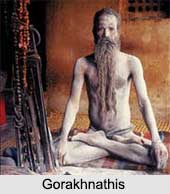 Order of the Gorakhnathis does not believe in caste restrictions upon eating, drinking and smoking. Theoretical equality does not, however, extend to women, for Yogis do not allow their women folk to eat with them.
Order of the Gorakhnathis does not believe in caste restrictions upon eating, drinking and smoking. Theoretical equality does not, however, extend to women, for Yogis do not allow their women folk to eat with them.
The months most auspicious for the Initiation ceremonies of the Gorakhnathis are "Poush" (December-January), "Magh" (January-February), "Phalgun" (February-March) and "Chaitra" (March-April). The initiations are almost entirely confined to these months.
Initiation of Gorakhnathis
A candidate may be of almost any age. There are many boys of varying ages, who are fully initiated Kanphatas. Initiation is divided, roughly, into two stages:
i. The first, a probationary period, followed by ceremonies leading to preliminary discipleship; and
ii. The second, during which the ceremony of splitting the ears, which leads to complete membership in the sect, is performed.
An initiate in the first stage is called an "Aughar"; in the second stage he becomes a full-fledged "Yogi".
Initiation usually takes place at a monastery, but it may be performed at a place of pilgrimage, or at a temple. The candidate is first closely confined for a period ranging from 40 days to from 3 to 6 months; that is, for a period of testing satisfactory to the guru. During this time the candidate is tried as to his resolution and ability to carry through his undertaking. At the same time he is dissuaded from becoming a Yogi, the guru pointing out to him the hardships that his initiation and his life as a Yogi would entail. When the guru is satisfied with the self-control and resolution shown by the candidate, a fast of 2 or 3 days may be prescribed.
On the day chosen for the initiation ceremony, the candidate bathes and appears before his guru, ringing with him a rupee and a quarter, a coconut, flowers and sweets. The latter are distributed amongst those present. A two-edged knife, with which the ears are to be split in the second stage of initiation, is presented to the candidate three times, and he is again dissuaded from proceeding with the ceremony. The knife is driven into the ground, or is laid down before him and the candidate takes the necessary vows over it. The candidate"s body is then smeared with ashes. He is now the accepted disciple of his guru and begins to serve his religious guide. Those who have undergone the first stage of initiation are usually termed "Aughars". The Aughar serves his guru, attends his teaching, and performs certain duties about the establishment where he lives.
There is no stated period of service before which an Aughar may proceed with the final stage of initiation which will constitute him a "Yogi". At any time, when his guru is satisfied that he is ready the disciple may proceed with the initiation and the arrangements are made. First, the candidate bathes, is shaved, puts ashes on his body and ties a cloth of cotton. The candidate is made to sit facing north. Preparation for the splitting of the two ears is then made. The ceremony of initiation is completed with the worship of the 9 Nathas, the 84 Siddhas and Balasundari. The Goddess is represented by a twisted thread wick fixed in a ball of dough and lighted. The light is worshipped with offerings of flowers, sweets and a coconut. The latter is split with a knife before being offered.
After initiation, a Yogi may elect to become a militant Yogi, vowed to celibacy. In this case he would be known as "Naga", "Nihang" or "Kanphata". The initiate becomes a member of the sub-sect of his guru; consequently, in choosing his guru, he chooses his sub-sect.




















